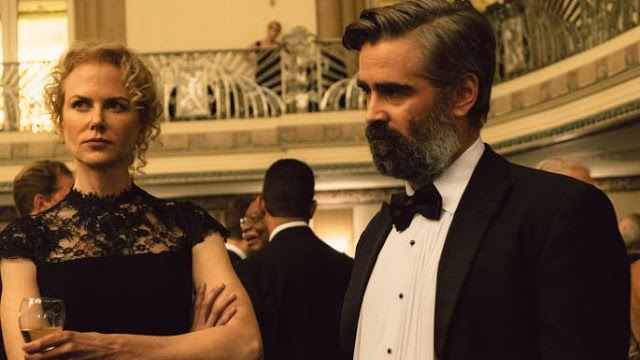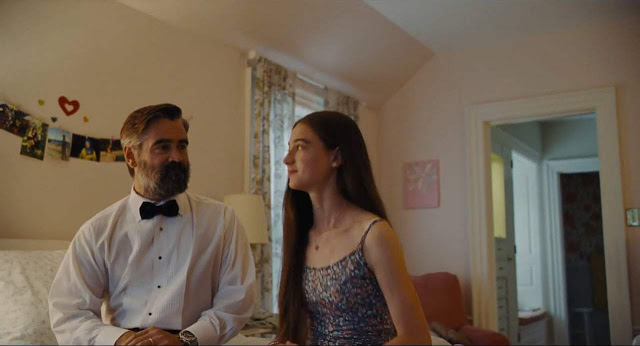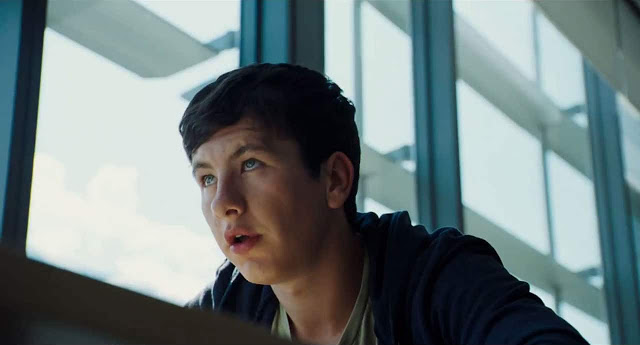Weirdness is Yorgos Lanthimos’ calling card. His breakout film, Dogtooth, was about three homeschooled adult children who were so shielded from the outside world, they didn’t understand the concept of names and they perceived housecats as deadly animals; that’s weird. His follow-up, Alps, tracked a troupe of performers who interrogated the critically injured as they died, then impersonated them for their families; that’s also weird. And his best movie, last year’s The Lobster, took place in a dystopian society where singles who failed to find romantic mates were transformed into animals; that’s very weird. So it’s something of a shock that The Killing of a Sacred Deer, Lanthimos’ punishing and baffling and routinely astonishing new film, arrives bearing no hallmarks of obvious strangeness. It’s set in a Cincinnati suburb. It focuses on a happy and healthy nuclear family. Its characters attend casual barbecues and black-tie functions. Nobody kills a cat, and nobody gets turned into a dog. Has Lanthimos, our foremost purveyor of allegorical absurdity, lost his edge?
Hardly. Not that this movie, which is one of the more harrowing features I’ve seen in several years, is a sneaky bait-and-switch. Despite its ostensible banality—its tree-lined streets and sterile hospitals, its family dinners and choir practices—The Killing of a Sacred Deer isn’t trying to lull you into complacency. Lanthimos may be unsparing toward his characters, but he plays fair with his audience. He announces his severity with his strikingly grotesque opening shot: a close-up of a man’s open chest cavity, his heart thump-thumping like a ghastly metronome. The camera gradually pulls back, revealing the hands of a doctor snipping flesh, and as the horns of a Schubert oratorio blare on the soundtrack, Lanthimos makes plain that he’s out for blood.
But whose? The most obvious candidate for exsanguination is Steven (Colin Farrell, gratefully clinging to a director who knows how to use his talents), a successful heart surgeon with a salt-and-pepper beard and “soft, beautiful hands”. Steven is in many ways an avatar of privilege, which marks him as a potential target of retribution. He lives in a handsome suburban home, which he shares with his wife, Anna (Nicole Kidman), and their two children, 14-year-old Kim (Tomorrowland’s Raffey Cassidy) and 10-year-old Bob (Sunny Suljic). The tranquility of their domestic life is so blissful that even their problems—Bob refuses to get a haircut; nobody watered the plants—are quaint and charming.
Yet something is off. You know this because Lanthimos has structured The Killing of a Sacred Deer according to the cues and rhythms of a horror movie. The music and sound design, supervised by Johnnie Burn, are dissonant and atonal, with sudden bursts of classical compositions (Bach, Ligeti) only reinforcing their sonic eeriness. Lingering exterior shots of buildings and cars create a portentous atmosphere, as though a bolt of lightning is about to shatter the screen. The editing is just jagged enough to be noticeable. You will be uneasy, even when the characters appear relaxed.
But because Lanthimos is an extraordinarily patient storyteller, the whispered implications of the film’s trembling gravity are more felt than seen, and you begin to question not just Steven and Anna but your own assumptions about them. Are they secret murderers? Drug-dealers? Pederasts? Or might they just be perfectly lovely people who in fact are—with the exception of a few colorful bedroom preferences—exceedingly normal?
While you’re inevitably pondering the characters’ true selves, you cannot help but take rapture in Lanthimos’ exacting craft. His meticulousness, honed with each new film, pays enormous dividends here, intensifying the movie’s otherworldly air while simultaneously grounding it in its manicured lawns and gleaming surfaces. The camera, operated by his regular collaborator Thimios Bakatakis, often remains unnervingly still; when it moves, it does so with absolute purpose. Many anxious directors feel compelled to boost their suspense with jitters and stunts. Lanthimos shakes you up by keeping things steady.
Steadiness is the surgeon’s gift, and Steven carries himself with a certitude that hovers between confidence and arrogance. In one sense, he is similar to David, the lovelorn hero of The Lobster whom Farrell played with such heartbreaking sadness. He seems similarly gentle and reserved, and he speaks in the same clipped, mannered style; indeed, all of Sacred Deer’s characters are unfailingly polite, which is part of what makes them scary. (Lanthimos composed the screenplay with his usual writing partner, Efthymis Filippou.) Yet Steven proves to be made of darker stuff, a man of cold and terrible pride who suddenly risks losing his certainty—along with his worldview, his livelihood, and his family—thanks to the actions of a strange teenage boy.
That boy is Martin (Barry Keoghan, the boy from Dunkirk), and he’s actually one of the first people we meet in Sacred Deer, wolfing down a piece of pie in a diner as Steven looks on affectionately. The parameters of their relationship are initially left intentionally obscure, and it’s fair to wonder if Steven has chosen to look after the boy as a sort of mentoring project, perhaps regarding him as a kindred spirit. After all, like Steven, Martin is courteous, smart, and soft-spoken. He is also, it turns out, a sorcerer.
Or something. Bear with me here. As The Killing of a Sacred Deer progresses, it reveals itself to be an allegorical fable, a bold and provocative tale of guilt and wrath. After young Bob is hospitalized with a mysterious case of paralysis, Martin informs Steven that his son’s sudden illness is not an accident but the product of Martin’s will. Some years ago, Martin’s father died on Steven’s operating table; now, Martin is demanding a life in return. And so, he calmly explains under the sickly lighting of a hospital cafeteria, Steven must now kill one of the three members of his family; if he does not, all three will gradually lose the use of their legs, then stop eating, then bleed from their eyes, and finally die.
You’re kidding, right? Naturally, Steven (a man of science) reacts to Martin’s chilling pronouncement with disbelief and disgust. You might do the same; to be sure, appreciation of this movie requires a surrendering of skepticism. But Lanthimos makes that easy, partly because Steven acts as an audience surrogate—his refusal to accept the supernatural forces at work may mirror your own—and partly because Lanthimos’ slow articulation of the inexorable workings of Martin’s curse is furiously compelling. In classic horror-movie tradition, every scene starts to carry a charge of nauseating tension, except that instead of waiting for a monster to leap from the shadows, you’re wondering if Kim and Anna will just collapse where they stand.
This is very frightening; it is also upsettingly funny. The Killing of a Sacred Deer may lack The Lobster’s stealth romanticism, but it replicates its jet-black humor, conveying its Sophie’s Choice-meets-The Lottery scenario with macabre wit. As the legitimacy of Martin’s prophecy becomes increasingly clear, the characters’ Darwinian impulses begin to assert themselves, leading to pitiful displays of self-serving salesmanship. Meanwhile, Steven’s persistent reliance on logic propels him toward absurdity, as when he visits a school official and gently inquires which of his two children their teachers think is better.
Of course, Lanthimos is after more than sudden shocks and bleak laughs. He strives to invest The Killing of a Sacred Deer with a power that’s symbolic as well as literal, turning Steven’s predicament into an acrid commentary on (I think) white privilege. As Martin bluntly states at one point, when justifying the ruin he’s bringing upon Steven’s family: “It’s metaphorical.”
No kidding. Yet the blow of that metaphor does not land quite as forcefully as Lanthimos may have hoped. Is Martin a righteous class warrior, visiting vengeance upon the one percent, or is he simply a symbol of the universe’s karmic cruelty? Is Steven a callous monster, indifferent to those who lack his fortunate circumstances, or is he a victim of entropy and mad jealousy? It’s hard to say, and the muddled nature of Sacred Deer’s allegory perhaps exposes a deeper problem. Unlike The Lobster, which undergirded its twisted love games with the spark of genuine romance and feeling, The Killing of a Sacred Deer is decidedly lacking in compassion. Like Martin, it just wants to inflict pain, and it will not rest until it has secured its pound of flesh.
But oh, it does it so beautifully. Like his compatriot in rigorous savagery, Michael Haneke, Lanthimos uses his clinical precision to create a mesmerizing, suffocating ambiance; you may be horrified by what you see, but you’d never dream of looking away. (He also draws out another terrific performance from Farrell, who leverages his innate charm and intelligence to make Steven an unknowable enigma, at once decent and sinister, calculated and desperate.) As its screws tighten and its walls close in, The Killing of a Sacred Deer’s metaphorical muddiness melts away, leaving in its place only pure, hypnotic terror. Were the film less artfully conceived, maybe I would object, grumbling about its needless sadism, its extremity, its dubious thematic relevance. But as it stands, I’m not inclined to worry about such trivialities. After all, it’s hard to voice complaint when a movie has struck you dumb.
Jeremy Beck is the editor-in-chief of MovieManifesto. He watches more movies and television than he probably should.




